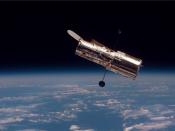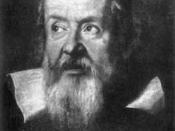From early star gazing through primitive telescopes to t
test rockets to sophisticated
satellites, the human expansion into space is perhaps the most amazing engineering feat
of the 20th century. The development of space technology has thrilled the world,
expanded our knowledge base, and improved our capabilities. Thousand of useful
products and services have resulted from space technology, including medical devices,
improved weather forecasting, and wireless communications.
English scientist Roger Bacon first described the fundamental optical principles of
the telescope in the 13th century. Dutch spectacle-maker Hans Lippershey is credited
with inventing the first telescope in the year 1608, when he discovered that a distant
object appeared to be much closer when viewed through a concave lens and a convex
lens held in front of each other. He mounted the lenses in a tube to make the first
refracting telescope.
Early telescopes were not used to explore the heavens; rather, they were
employed for military purposes, to detect advancing armies or ships.
News of the
telescope's invention spread rapidly through Europe. Glass grinding and polishing
techniques, which had been developed since the 13th century, made it easy for the
telescope design to be constructed and improved. Science historians credit Italian
scientist Galileo with the first use of the telescope for scientific observations of
astronomical objects. In 1609, using a homemade telescope that could magnify objects to
20 times the size seen by the naked eye, Galileo discovered four moons orbiting the
Juarez2
planet Jupiter. By the end of the following year, he had used his telescope to resolve the
Milky Way Galaxy into countless stars, see dark spots on the Sun, and map the face of
the Moon.
A modern astronomical telescope weighs hundreds of tons, yet it is able to swing
smoothly to point at any part of the...



Mistake
The text states:'While the postwar U.S. leaders still believed bombers were better suited to their needs, the Soviets continued to develop rockets and ballistic missiles.'
That is untrue. With assistance of German scientists like Werner von Braun, the USA used the basis of the German V-2 rockets to develop the 'redstone' rockets in the 1950's. Then they went on to develop the 'jupiter rocket', which launched the first American satellite into space in 1958 (jupiter c rocket).
2 out of 2 people found this comment useful.